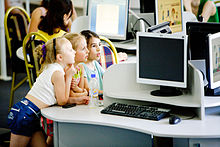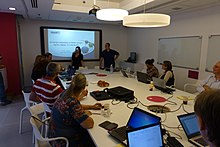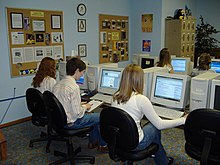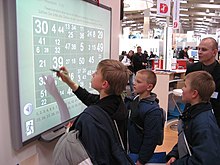
A | B | C | D | E | F | G | H | CH | I | J | K | L | M | N | O | P | Q | R | S | T | U | V | W | X | Y | Z | 0 | 1 | 2 | 3 | 4 | 5 | 6 | 7 | 8 | 9
| Educational research |
|---|
| Disciplines |
| Curricular domains |
| Methods |
Educational technology (commonly abbreviated as edutech, or edtech) is the combined use of computer hardware, software, and educational theory and practice to facilitate learning.[1][2] When referred to with its abbreviation, "EdTech," it often refers to the industry of companies that create educational technology.[3][4][5] In EdTech Inc.: Selling, Automating and Globalizing Higher Education in the Digital Age, Tanner Mirrlees and Shahid Alvi (2019) argue "EdTech is no exception to industry ownership and market rules" and "define the EdTech industries as all the privately owned companies currently involved in the financing, production and distribution of commercial hardware, software, cultural goods, services and platforms for the educational market with the goal of turning a profit. Many of these companies are US-based and rapidly expanding into educational markets across North America, and increasingly growing all over the world."[3]
In addition to the practical educational experience, educational technology is based on theoretical knowledge from various disciplines such as communication, education, psychology, sociology, artificial intelligence, and computer science.[6] It encompasses several domains including learning theory, computer-based training, online learning, and m-learning where mobile technologies are used.
Definition
The Association for Educational Communications and Technology (AECT) has defined educational technology as "the study and ethical practice of facilitating learning and improving performance by creating, using and managing appropriate technological processes and resources".[7] It denotes instructional technology as "the theory and practice of design, development, utilization, management, and evaluation of processes and resources for learning".[8][9][10] As such, educational technology refers to all valid and reliable applied education sciences, such as equipment, as well as processes and procedures that are derived from scientific research, and in a given context may refer to theoretical, algorithmic or heuristic processes: it does not necessarily imply physical technology. Educational technology is the process of integrating technology into education in a positive manner that promotes a more diverse learning environment and a way for students to learn how to use technology as well as their common assignments.
Accordingly, there are several discrete aspects to describing the intellectual and technical development of educational technology:
- Educational technology as the theory and practice of educational approaches to learning.
- Educational technology as technological tools and media, for instance massive online courses, that assist in the communication of knowledge, and its development and exchange. This is usually what people are referring to when they use the term "edtech".
- Educational technology for learning management systems (LMS), such as tools for student and curriculum management, and education management information systems (EMIS).
- Educational technology as back-office management, such as training management systems for logistics and budget management, and Learning Record Store (LRS) for learning data storage and analysis.
- Educational technology itself as an educational subject; such courses may be called "computer studies" or "information and communications technology (ICT)".[11]
Related terms

Educational technology is an inclusive term for both the material tools and processes, and the theoretical foundations for supporting learning and teaching. Educational technology is not restricted to advanced technology but is anything that enhances classroom learning in the utilization of blended, face-to-face, or online learning.[12]
An educational technologist is someone who is trained in the field of educational technology. Educational technologists try to analyze, design, develop, implement, and evaluate processes and tools to enhance learning.[13] While the term educational technologist is used primarily in the United States, learning technologist is a synonymous term used in the UK[14] as well as Canada.
Modern electronic educational technology is an important part of society today.[15] Educational technology encompasses e-learning, instructional technology, information and communication technology (ICT) in education, edtech, learning technology, multimedia learning, technology-enhanced learning (TEL), computer-based instruction (CBI), computer managed instruction, computer-based training (CBT), computer-assisted instruction or computer-aided instruction (CAI),[16] internet-based training (IBT), flexible learning, web-based training (WBT), online education, digital educational collaboration, distributed learning, computer-mediated communication, cyber-learning, and multi-modal instruction, virtual education, personal learning environments, networked learning, virtual learning environments (VLE) (which are also called learning platforms), m-learning, ubiquitous learning and digital education.
Each of these numerous terms has had its advocates, who point up potential distinctive features.[17] However, many terms and concepts in educational technology have been defined nebulously; for example, Fiedler's review of the literature found a complete lack of agreement about the components of a personal learning environment. Moreover, Moore saw these terminologies as emphasizing particular features such as digitization approaches, components, or delivery methods rather than being fundamentally dissimilar in concept or principle.[17] For example, m-learning emphasizes mobility, which allows for altered timing, location, accessibility, and context of learning; nevertheless, its purpose and conceptual principles are those of educational technology.[17]
In practice, as technology has advanced, the particular "narrowly defined" terminological aspect that was initially emphasized by name has blended into the general field of educational technology.[17] Initially, "virtual learning" as narrowly defined in a semantic sense implied entering an environmental simulation within a virtual world, for example in treating posttraumatic stress disorder (PTSD).[18][19] In practice, a "virtual education course" refers to any instructional course in which all, or at least a significant portion, is delivered by the Internet. "Virtual" is used in that broader way to describe a course that is not taught in a classroom face-to-face but through a substitute mode that can conceptually be associated "virtually" with classroom teaching, which means that people do not have to go to the physical classroom to learn. Accordingly, virtual education refers to a form of distance learning in which course content is delivered by various methods such as course management applications, multimedia resources, and videoconferencing.[20] Virtual education and simulated learning opportunities, such as games or dissections, offer opportunities for students to connect classroom content to authentic situations.[21]
Educational content, pervasively embedded in objects, is all around the learner, who may not even be conscious of the learning process.[22] The combination of adaptive learning, using an individualized interface and materials, which accommodate to an individual, who thus receives personally differentiated instruction, with ubiquitous access to digital resources and learning opportunities in a range of places and at various times, has been termed smart learning.[23][24][25] Smart learning is a component of the smart city concept.[26][27]
History

Helping people and children learn in ways that are easier, faster, more accurate, or less expensive can be traced back to the emergence of very early tools, such as paintings on cave walls.[28][29] Various types of abacus have been used. Writing slates and blackboards have been used for at least a millennium.[30] Since their introduction, books and pamphlets have played a prominent role in education. From the early twentieth century, duplicating machines such as the mimeograph and Gestetner stencil devices were used to produce short copy runs (typically 10–50 copies) for classroom or home use. The use of media for instructional purposes is generally traced back to the first decade of the 20th century[31] with the introduction of educational films (the 1900s) and Sidney Pressey's mechanical teaching machines (1920s). The first all multiple choice, large-scale assessment was the Army Alpha, used to assess the intelligence and, more specifically, the aptitudes of World War I military recruits. Further large-scale use of technologies was employed in training soldiers during and after WWII using films and other mediated materials, such as overhead projectors. The concept of hypertext is traced to the description of memex by Vannevar Bush in 1945.

Slide projectors were widely used during the 1950s in educational institutional settings. Cuisenaire rods were devised in the 1920s and saw widespread use from the late 1950s.
In the mid-1960s, Stanford University psychology professors, Patrick Suppes and Richard C. Atkinson, experimented with using computers to teach arithmetic and spelling via Teletypes to elementary school students in the Palo Alto Unified School District in California.[32][33] Stanford's Education Program for Gifted Youth is descended from those early experiments.
Online education originated from the University of Illinois in 1960. Although the internet would not be created for another decade, students were able to access class information with linked computer terminals. Online learning emerged in 1982 when the Western Behavioral Sciences Institute in La Jolla, California, opened its School of Management and Strategic Studies. The school employed computer conferencing through the New Jersey Institute of Technology's Electronic Information Exchange System (EIES) to deliver a distance education program to business executives.[34] Starting in 1985, Connected Education offered the first totally online master's degree in media studies, through The New School in New York City, also via the EIES computer conferencing system.[35][36][37] Subsequent courses were offered in 1986 by the Electronic University Network for DOS and Commodore 64 computers. In 2002, MIT began providing online classes free of charge. As of 2009[update], approximately 5.5 million students were taking at least one class online. Currently, one out of three college students takes at least one online course while in college. At DeVry University, out of all students that are earning a bachelor's degree, 80% earn two-thirds of their requirements online. Also, in 2014, 2.85 million students out of 5.8 million students that took courses online, took all of their courses online. From this information, it can be concluded that the number of students taking classes online is on a steady increase.[38][39]

The recent article, "Shift Happens: Online Education as a New Paradigm in Learning", Linda Harasim covers an overview of the history of online education as well as a framework for understanding the type of need it addresses. The concept of distance learning has already been invented for many centuries. The value of online education is not found in its ability to establish a method for distance learning, but rather in its power to make this type of learning process more efficient by providing a medium in which the instructor and their students can virtually interact with one another in real-time. The topic of online education started primarily in the late 1900s when institutions and businesses started to make products to assist students' learning. These groups desired a need to further develop educational services across the globe, primarily to developing countries. In 1960, the University of Illinois created a system of linked computer terminals, known as the Intranet, to give students access to recorded lectures and course materials that they could watch or use in their free time. This type of concept, called PLATO (programmed logic for automatic teaching operations), was rapidly introduced throughout the globe. Many institutions adopted this similar technique while the internet was in its developmental phase.
In 1971, Ivan Illich published a hugely influential book, Deschooling Society, in which he envisioned "learning webs" as a model for people to network the learning they needed. The 1970s and 1980s saw notable contributions in computer-based learning by Murray Turoff and Starr Roxanne Hiltz at the New Jersey Institute of Technology[40] as well as developments at the University of Guelph in Canada.[41] In the UK, the Council for Educational Technology supported the use of educational technology, in particular administering the government's National Development Programme in Computer Aided Learning[42] (1973–1977) and the Microelectronics Education Programme (1980–1986).
By the mid-1980s, accessing course content became possible at many college libraries. In computer-based training (CBT) or computer-based learning (CBL), the learning interaction was between the student and computer drills or micro-world simulations.
Digitized communication and networking in education started in the mid-1980s. Educational institutions began to take advantage of the new medium by offering distance learning courses using computer networking for information. Early e-learning systems, based on computer-based learning/training often replicated autocratic teaching styles whereby the role of the e-learning system was assumed to be for transferring knowledge, as opposed to systems developed later based on computer-supported collaborative learning (CSCL), which encouraged the shared development of knowledge.
Videoconferencing was an important forerunner to the educational technologies known today. This work was especially popular with museum education. Even in recent years, videoconferencing has risen in popularity to reach over 20,000 students across the United States and Canada in 2008–2009. Disadvantages of this form of educational technology are readily apparent: image and sound quality are often grainy or pixelated; videoconferencing requires setting up a type of mini-television studio within the museum for broadcast; space becomes an issue; and specialized equipment is required for both the provider and the participant.[43]
The Open University in Britain[41] and the University of British Columbia (where Web CT, now incorporated into Blackboard Inc., was first developed) began a revolution of using the Internet to deliver learning,[44] making heavy use of web-based training, online distance learning, and online discussion between students.[45] Practitioners such as Harasim (1995)[46] put heavy emphasis on the use of learning networks.
With the advent of the World Wide Web in the 1990s, teachers embarked on the method of using emerging technologies to employ multi-object oriented sites, which are text-based online virtual reality systems, to create course websites along with simple sets of instructions for their students.
By 1994, the first online high school had been founded. In 1997, Graziadei described criteria for evaluating products and developing technology-based courses that include being portable, replicable, scalable, affordable, and having a high probability of long-term cost-effectiveness.[47]
Improved Internet functionality enabled new schemes of communication with multimedia or webcams. The National Center for Education Statistics estimates the number of K-12 students enrolled in online distance learning programs increased by 65% from 2002 to 2005, with greater flexibility, ease of communication between teacher and student, and quick lecture and assignment feedback.
According to a 2008 study conducted by the U.S Department of Education, during the 2006–2007 academic year about 66% of postsecondary public and private schools participating in student financial aid programs offered some distance learning courses; records show 77% of enrollment in for-credit courses with an online component.[48] In 2008, the Council of Europe passed a statement endorsing e-learning's potential to drive equality and education improvements across the EU.[49]
Computer-mediated communication (CMC) is between learners and instructors, mediated by the computer. In contrast, CBT/CBL usually means individualized (self-study) learning, while CMC involves educator/tutor facilitation and requires the scalarization of flexible learning activities. In addition, modern ICT provides education with tools for sustaining learning communities and associated knowledge management tasks.
Students growing up in this digital age have extensive exposure to a variety of media.[50] Major high-tech companies have funded schools to provide them with the ability to teach their students through technology.[51]
2015 was the first year that private nonprofit organizations enrolled more online students than for-profits, although public universities still enrolled the highest number of online students. In the fall of 2015, more than 6 million students enrolled in at least one online course.[52]
In 2020, due to the COVID-19 pandemic, many schools across the world were forced to close, which left more and more grade-school students participating in online learning, and university-level students enrolling in online courses to enforce distance learning.[53][54] Organizations such as Unesco have enlisted educational technology solutions to help schools facilitate distance education.[55] The pandemic's extended lockdowns and focus on distance learning has attracted record-breaking amounts of venture capital to the ed-tech sector.[56] In 2020, in the United States alone, ed-tech startups raised $1.78 billion in venture capital spanning 265 deals, compared to $1.32 billion in 2019.[57]
Theory
Various pedagogical perspectives or learning theories may be considered in designing and interacting with educational technology. E-learning theory examines these approaches. These theoretical perspectives are grouped into three main theoretical schools or philosophical frameworks: behaviorism, cognitivism, and constructivism.
Behaviorism
This theoretical framework was developed in the early 20th century based on animal learning experiments by Ivan Pavlov, Edward Thorndike, Edward C. Tolman, Clark L. Hull, and B.F. Skinner. Many psychologists used these results to develop theories of human learning, but modern educators generally see behaviorism as one aspect of a holistic synthesis. Teaching in behaviorism has been linked to training, emphasizing animal learning experiments. Since behaviorism consists of the view of teaching people how to do something with rewards and punishments, it is related to training people.[58]
B.F. Skinner wrote extensively on improvements in teaching based on his functional analysis of verbal behavior[59][60] and wrote "The Technology of Teaching",[61][62] an attempt to dispel the myths underlying contemporary education as well as promote his system he called programmed instruction. Ogden Lindsley developed a learning system, named Celeration, which was based on behavior analysis but substantially differed from Keller's and Skinner's models.
Cognitivism
Cognitive science underwent significant change in the 1960s and 1970s to the point that some described the period as a "cognitive revolution", particularly in reaction to behaviorism.[63] While retaining the empirical framework of behaviorism, cognitive psychology theories look beyond behavior to explain brain-based learning by considering how human memory works to promote learning. It refers to learning as "all processes by which the sensory input is transformed, reduced, elaborated, stored, recovered, and used" by the human mind.[63][64] The Atkinson-Shiffrin memory model and Baddeley's working memory model were established as theoretical frameworks. Computer science and information technology have had a major influence on cognitive science theory. The cognitive concepts of working memory (formerly known as short-term memory) and long-term memory have been facilitated by research and technology from the field of computer science. Another major influence on the field of cognitive science is Noam Chomsky. Today researchers are concentrating on topics like cognitive load, information processing, and media psychology. These theoretical perspectives influence instructional design.[65]
There are two separate schools of cognitivism, and these are the cognitivist and social cognitivist. The former focuses on the understanding of the thinking or cognitive processes of an individual while the latter includes social processes as influences in learning besides cognition.[66] These two schools, however, share the view that learning is more than a behavioral change but is rather a mental process used by the learner.[66]
Constructivism
Educational psychologists distinguish between several types of constructivism: individual (or psychological) constructivism, such as Piaget's theory of cognitive development, and social constructivism. This form of constructivism has a primary focus on how learners construct their own meaning from new information, as they interact with reality and with other learners who bring different perspectives. Constructivist learning environments require students to use their prior knowledge and experiences to formulate new, related, and/or adaptive concepts in learning (Termos, 2012[67]). Under this framework, the role of the teacher becomes that of a facilitator, providing guidance so that learners can construct their own knowledge. Constructivist educators must make sure that the prior learning experiences are appropriate and related to the concepts being taught. Jonassen (1997) suggests "well-structured" learning environments are useful for novice learners and that "ill-structured" environments are only useful for more advanced learners. Educators utilizing a constructivist perspective may emphasize an active learning environment that may incorporate learner-centered problem-based learning, project-based learning, and inquiry-based learning, ideally involving real-world scenarios, in which students are actively engaged in critical thinking activities. An illustrative discussion and example can be found in the 1980s deployment of constructivist cognitive learning in computer literacy, which involved programming as an instrument of learning.[68]: 224 LOGO, a programming language, embodied an attempt to integrate Piagetian ideas with computers and technology.[68][69] Initially there were broad, hopeful claims, including "perhaps the most controversial claim" that it would "improve general problem-solving skills" across disciplines.[68]: 238 However, LOGO programming skills did not consistently yield cognitive benefits.[68]: 238 It was "not as concrete" as advocates claimed, it privileged "one form of reasoning over all others", and it was difficult to apply the thinking activity to non-LOGO-based activities.[70] By the late 1980s, LOGO and other similar programming languages had lost their novelty and dominance and were gradually de-emphasized amid criticisms.[71]
Practice
The extent to which e-learning assists or replaces other learning and teaching approaches is variable, ranging on a continuum from none to fully online distance learning.[72][73] A variety of descriptive terms have been employed (somewhat inconsistently) to categorize the extent to which technology is used. For example, "hybrid learning" or "blended learning" may refer to classroom aids and laptops, or may refer to approaches in which traditional classroom time is reduced but not eliminated, and is replaced with some online learning.[74][75] "Distributed learning" may describe either the e-learning component of a hybrid approach, or fully online distance learning environments.[72]
Synchronous and asynchronous
E-learning may either be synchronous or asynchronous. Synchronous learning occurs in real-time, with all participants interacting at the same time. In contrast, asynchronous learning is self-paced and allows participants to engage in the exchange of ideas or information without the dependency on other participants' involvement at the same time.[76]
Synchronous learning refers to exchanging ideas and information with one or more participants during the same period. Examples are face-to-face discussion, online real-time live teacher instruction and feedback, Skype conversations, and chat rooms or virtual classrooms where everyone is online and working collaboratively at the same time. Since students are working collaboratively, synchronized learning helps students become more open-minded because they have to actively listen and learn from their peers. Synchronized learning fosters online awareness and improves many students' writing skills.[77]
Asynchronous learning may use technologies such as learning management systems, email, blogs, wikis, and discussion boards, as well as web-supported textbooks,[78] hypertext documents, audio[79] video courses, and social networking using web 2.0. At the professional educational level, training may include virtual operating rooms. Asynchronous learning is beneficial for students who have health problems or who have childcare responsibilities. They have the opportunity to complete their work in a low-stress environment and within a more flexible time frame.[45] In asynchronous online courses, students are allowed the freedom to complete work at their own pace. Being non-traditional students, they can manage their daily life and school and still have the social aspect. Asynchronous collaborations allow the student to reach out for help when needed and provide helpful guidance, depending on how long it takes them to complete the assignment. Many tools used for these courses are but are not limited to: videos, class discussions, and group projects.[80] Through online courses, students can earn their diplomas faster, or repeat failed courses without being in a class with younger students. Students have access to various enrichment courses in online learning, still participate in college courses, internships, sports, or work, and still graduate with their classes.
Linear learning
Computer-based training (CBT) refers to self-paced learning activities delivered on a computer or handheld devices such as a tablet or smartphone. CBT initially delivered content via CD-ROM, and typically presented content linearly, much like reading an online book or manual.[81] For this reason, CBT is often used to teach static processes, such as using software or completing mathematical equations. Computer-based training is conceptually similar to web-based training (WBT), which is delivered via Internet using a web browser.
Assessing learning in a CBT is often by assessments that can be easily scored by a computer such as multiple-choice questions, drag-and-drop, radio button, simulation, or other interactive means. Assessments are easily scored and recorded via online software, providing immediate end-user feedback and completion status. Users are often able to print completion records in the form of certificates.[81]
CBTs provide learning stimulus beyond traditional learning methodology from textbook, manual, or classroom-based instruction. CBTs can be a good alternative to printed learning materials since rich media, including videos or animations, can be embedded to enhance learning.[81]
However, CBTs pose some learning challenges. Typically, the creation of effective CBTs requires enormous resources. The software for developing CBTs is often more complex than a subject matter expert or teacher is able to use.[81] The lack of human interaction can limit both the type of content that can be presented and the type of assessment that can be performed and may need supplementation with online discussion or other interactive elements.
Collaborative learning
Computer-supported collaborative learning (CSCL) uses instructional methods designed to encourage or require students to work together on learning tasks, allowing social learning. CSCL is similar in concept to the terminology, "e-learning 2.0" and "networked collaborative learning" (NCL).[82] With Web 2.0 advances, sharing information between multiple people in a network has become much easier and use has increased.[81][83]: 1 [84] One of the main reasons for its usage states that it is "a breeding ground for creative and engaging educational endeavors."[83]: 2 Learning takes place through conversations about content and grounded interaction about problems and actions. This collaborative learning differs from instruction in which the instructor is the principal source of knowledge and skills.[81] The neologism "e-learning 1.0" refers to direct instruction used in early computer-based learning and training systems (CBL). In contrast to that linear delivery of content, often directly from the instructor's material, CSCL uses social software such as blogs, social media, wikis, podcasts, cloud-based document portals, discussion groups and virtual worlds.[85] This phenomenon has been referred to as Long Tail Learning.[86] Advocates of social learning claim that one of the best ways to learn something is to teach it to others.[86] Social networks have been used to foster online learning communities around subjects as diverse as test preparation and language education. Mobile-assisted language learning (MALL) is the use of handheld computers or cell phones to assist in language learning.
Collaborative apps allow students and teachers to interact while studying. Apps are designed after games, which provide a fun way to revise. When the experience is enjoyable, the students become more engaged. Games also usually come with a sense of progression, which can help keep students motivated and consistent while trying to improve.[87]
Classroom 2.0 refers to online multi-user virtual environments (MUVEs) that connect schools across geographical frontiers. Known as "eTwinning", computer-supported collaborative learning (CSCL) allows learners in one school to communicate with learners in another that they would not get to know otherwise,[88][89] enhancing educational outcomes[90] and cultural integration.
Further, many researchers distinguish between collaborative and cooperative approaches to group learning. For example, Roschelle and Teasley (1995) argue that "cooperation is accomplished by the division of labor among participants, as an activity where each person is responsible for a portion of the problem solving", in contrast with collaboration that involves the "mutual engagement of participants in a coordinated effort to solve the problem together."[91]
Social technology, and social media specifically, provides avenues for student learning that would not be available otherwise. For example, it provides ordinary students a chance to exist in the same room as, and share a dialogue with researchers, politicians, and activists. This is because it vaporizes the geographical barriers that would otherwise separate people.[92] Simplified, social media gives students a reach that provides them with opportunities and conversations that allow them to grow as communicators.[93]
Social technologies like Twitter can provide students with an archive of free data that goes back multiple decades. Many classrooms and educators are already taking advantage of this free resource—for example, researchers and educators at the University of Central Florida in 2011 used Tweets posted relating to emergencies like Hurricane Irene as data points, in order to teach their students how to code data.[94][95] Social media technologies also allow instructors the ability to show students how professional networks facilitate work on a technical level.[96]
Flipped classroom
This is an instructional strategy where the majority of the initial learning occurs first at home using technology. Then, students will engage with higher-order learning tasks in the classroom with the teacher.[97] Often, online tools are used for the individual at-home learning, such as: educational videos, learning management systems, interactive tools, and other web-based resources.[98][99] Some advantages of flipped learning include improved learning performance, enhanced student satisfaction and engagement, flexibility in learning, and increased interaction opportunities between students and instructors.[100][101][102] On the other hand, the disadvantages of flipped learning involve challenges related to student motivation, internet accessibility, quality of videos, and increased workload for teachers.[103][104] It is important to note that the large majority of studies focusing on the success of flipped learning are in the higher education context.[105]
Technologies

Educational media and tools can be used for:
- task structuring support: help with how to do a task (procedures and processes),
- access to knowledge bases (help user find information needed)
- alternate forms of knowledge representation (multiple representations of knowledge, e.g. video, audio, text, image, data)
Numerous types of physical technology are currently used:[106][107] digital cameras, video cameras, interactive whiteboard tools, document cameras, electronic media, and LCD projectors. Combinations of these techniques include blogs, collaborative software, ePortfolios, and virtual classrooms.[108]
The current design of this type of application includes the evaluation through tools of cognitive analysis that allow one to identify which elements optimize the use of these platforms.[109]
Audio and video

Video technology[110] has included VHS tapes and DVDs, as well as on-demand and synchronous methods with digital video via server or web-based options such as streamed video and webcams. Videotelephony can connect with speakers and other experts. Interactive digital video games are being used at K-12 and higher education institutions.[111]
Radio offers a synchronous educational vehicle while streaming audio over the internet with webcasts and podcasts can be asynchronous. Classroom microphones, often wireless, can enable learners and educators to interact more clearly.
Screencasting allows users to share their screens directly from their browser and make the video available online so that other viewers can stream the video directly.[112] The presenter thus has the ability to show their ideas and flow of thoughts rather than simply explain them as simple text content. In combination with audio and video, the educator can mimic the one-on-one experience of the classroom. Learners have the ability to pause and rewind, to review at their own pace, something a classroom cannot always offer.
Webcams and webcasting have enabled the creation of virtual classrooms and virtual learning environments.[113] Webcams are also being used to counter plagiarism and other forms of academic dishonesty that might occur in an e-learning environment.
Computers, tablets, and mobile devices

Collaborative learning is a group-based learning approach in which learners are mutually engaged in a coordinated fashion to achieve a learning goal or complete a learning task. With recent developments in smartphone technology, the processing powers and storage capabilities of modern mobiles allow for advanced development and the use of apps. Many app developers and education experts have been exploring smartphone and tablet apps as a medium for collaborative learning.
Computers and tablets enable learners and educators to access websites as well as applications. Many mobile devices support m-learning.[114]
Mobile devices such as clickers and smartphones can be used for interactive audience response feedback.[115] Mobile learning can provide performance support for checking the time, setting reminders, retrieving worksheets, and instruction manuals.[116][117]
Such devices as iPads are used for helping disabled (visually impaired or with multiple disabilities) children in communication development as well as in improving physiological activity, according to the stimulation Practice Report.[118]
Studies in pre-school (early learning), primary and secondary education have explored how digital devices are used to enable effective learning outcomes, and create systems that can support teachers.[119] Digital technology can improve teaching and learning by motivating students with engaging, interactive, and fun learning environments. These online interactions enable further opportunities to develop digital literacy, 21st century skills, and digital citizenship.[119]
Single-board computers and Internet of Things
Embedded single-board computers and microcontrollers such as Raspberry Pi, Arduino and BeagleBone are easy to program, some can run Linux and connect to devices such as sensors, displays, LEDs and robotics. These are cost effective computing devices ideal for learning programming, which work with cloud computing and the Internet of Things. The Internet of things refers to a type of network to connect anything with the Internet-based on stipulated protocols through information sensing equipment to conduct information exchange and communications to achieve smart recognitions, positioning, tracking, monitoring, and administration.[120]These devices are part of a Maker culture that embraces tinkering with electronics and programming to achieve software and hardware solutions. The Maker Culture means there is a huge amount of training and support available.[121]
Collaborative and social learning
Group webpages, blogs, wikis, and Twitter allow learners and educators to post thoughts, ideas, and comments on a website in an interactive learning environment.[122][123] Social networking sites are virtual communities for people interested in a particular subject to communicate by voice, chat, instant message, video conference, or blogs.[124] The National School Boards Association found that 96% of students with online access have used social networking technologies and more than 50% talk online about schoolwork. Social networking encourages collaboration and engagement[125] and can be a motivational tool for self-efficacy amongst students.[126]
Whiteboards


There are three types of whiteboards.[127] The initial whiteboards, analogous to blackboards, date from the late 1950s. The term whiteboard is also used metaphorically to refer to virtual whiteboards in which computer software applications simulate whiteboards by allowing writing or drawing. This is a common feature of groupware for virtual meetings, collaboration, and instant messaging. Interactive whiteboards allow learners and instructors to write on the touch screen. The screen markup can be on either a blank whiteboard or any computer screen content. Depending on permission settings, this visual learning can be interactive and participatory, including writing and manipulating images on the interactive whiteboard.[127]
Virtual classroom
This section needs additional citations for verification. (March 2019) |
A virtual learning environment (VLE), also known as a learning platform, simulates a virtual classroom or meeting by simultaneously mixing several communication technologies. [128]Web conferencing software enables students and instructors to communicate with each other via webcam, microphone, and real-time chatting in a group setting. Participants can raise their hands, answer polls, or take tests. Students can whiteboard and screencast when given rights by the instructor, who sets permission levels for text notes, microphone rights, and mouse control.[129]
A virtual classroom provides an opportunity for students to receive direct instruction from a qualified teacher in an interactive environment.[130] Learners can have direct and immediate access to their instructor for instant feedback and direction. The virtual classroom provides a structured schedule of classes, which can be helpful for students who may find the freedom of asynchronous learning to be overwhelming. Besides, the virtual classroom provides a social learning environment that replicates the traditional "brick and mortar" classroom. [131]Most virtual classroom applications provide a recording feature. Each class is recorded and stored on a server, which allows for instant playback of any class over the course of the school year. This can be extremely useful for students to retrieve missed material or review concepts for an upcoming exam. Parents and auditors have the conceptual ability to monitor any classroom to ensure that they are satisfied with the education the learner is receiving.
In higher education especially, a virtual learning environment (VLE) is sometimes combined with a management information system (MIS) to create a managed learning environment, in which all aspects of a course are handled through a consistent user interface throughout the institution.[132] Physical universities and newer online-only colleges offer to select academic degrees and certificate programs via the Internet. Some programs require students to attend some campus classes or orientations, but many are delivered completely online. Several universities offer online student support services, such as online advising and registration, e-counseling, online textbook purchases, student governments, and student newspapers.[133]
Due to the COVID-19 pandemic, many schools have been forced to move online. As of April 2020, an estimated 90% of high-income countries are offering online learning, with only 25% of low-income countries offering the same.[134]
Augmented reality
Augmented reality (AR) provides students and teachers with the opportunity to create layers of digital information, including both virtual worlds and real-world elements, to interact in real-time.
AR technology plays an important role in the future of the classroom where human -I co-orchestration takes place seamlessly.[135] Students would switch between individual and collaborative learning dynamically, based on their own learning pace, while teachers, with the help of AR, monitor the classroom and provide necessary interventions in cases where computer systems are not yet designed to handle certain aspects. In this vision, the technology's role is to enhance, rather than replace, human teachers' capabilities.
Learning management system

A learning management system (LMS) is software used for delivering, tracking, and managing training and education. It tracks data about attendance, time on task, and student progress. Educators can post announcements, grade assignments, check on course activities, and participate in class discussions. Students can submit their work, read and respond to discussion questions, and take quizzes.[122] An LMS may allow teachers, administrators, and students, and permitted additional parties (such as parents, if appropriate) to track various metrics. LMSs range from systems for managing training/educational records to software for distributing courses over the Internet and offering features for online collaboration. The creation and maintenance of comprehensive learning content require substantial initial and ongoing investments in human labor. Effective translation into other languages and cultural contexts requires even more investment by knowledgeable personnel.[136]
Internet-based learning management systems include Canvas, Blackboard Inc. and Moodle. These types of LMS allow educators to run a learning system partially or fully online, asynchronously or synchronously. Learning Management Systems also offers a non-linear presentation of content and curricular goals, giving students the choice of pace and order of information learned.[21] Blackboard can be used for K-12 education, Higher Education, Business, and Government collaboration.[137] Moodle is a free-to-download Open Source Course Management System that provides blended learning opportunities as well as platforms for distance learning courses.[138]
Learning content management system
A learning content management system (LCMS) is software for author content (courses, reusable content objects). An LCMS may be solely dedicated to producing and publishing content that is hosted on an LMS, or it can host the content itself. The Aviation Industry Computer-Based Training Committee (AICC) specification provides support for content that is hosted separately from the LMS.
A recent trend in LCMSs is to address this issue through crowdsourcing (cf.SlideWiki[139]).
Computer-aided assessment
Computer-aided assessment (e-assessment) ranges from automated multiple-choice tests to more sophisticated systems. With some systems, feedback can be geared towards a student's specific mistakes, or the computer can navigate the student through a series of questions adapting to what the student appears to have learned or not learned. Formative assessment sifts out the incorrect answers, and these questions are then explained by the teacher. The learner then practices with slight variations of the sifted-out questions.[140] The process is completed by summative assessment using a new set of questions that only cover the topics previously taught.
Training management systemedit
A training management system or training resource management system is software designed to optimize instructor-led training management. Similar to an enterprise resource planning (ERP), it is a back office tool that aims at streamlining every aspect of the training process: planning (training plan and budget forecasting), logistics (scheduling and resource management), financials (cost tracking, profitability), reporting, and sales for-profit training providers.[141] A training management system can be used to schedule instructors, venues, and equipment through graphical agendas, optimize resource utilization, create a training plan and track remaining budgets, generate reports and share data between different teams.
While training management systems focus on managing instructor-led training, they can complete an LMS. In this situation, an LMS will manage e-learning delivery and assessment, while a training management system will manage ILT and back-office budget planning, logistics, and reporting.[142]
Standards and ecosystemedit
Learning objectsedit
Contentedit
Content and design architecture issues include pedagogy and learning object re-use. One approach looks at five aspects:[143]
- Fact – unique data (e.g. symbols for Excel formula, or the parts that make up a learning objective)
- Concept – a category that includes multiple examples (e.g. Excel formulas, or the various types/theories of instructional design) Zdroj:https://en.wikipedia.org?pojem=Information_and_communication_technologies_in_education
Text je dostupný za podmienok Creative Commons Attribution/Share-Alike License 3.0 Unported; prípadne za ďalších podmienok. Podrobnejšie informácie nájdete na stránke Podmienky použitia.
Antropológia
Aplikované vedy
Bibliometria
Dejiny vedy
Encyklopédie
Filozofia vedy
Forenzné vedy
Humanitné vedy
Knižničná veda
Kryogenika
Kryptológia
Kulturológia
Literárna veda
Medzidisciplinárne oblasti
Metódy kvantitatívnej analýzy
Metavedy
Metodika
Text je dostupný za podmienok Creative
Commons Attribution/Share-Alike License 3.0 Unported; prípadne za ďalších
podmienok.
Podrobnejšie informácie nájdete na stránke Podmienky
použitia.
www.astronomia.sk | www.biologia.sk | www.botanika.sk | www.dejiny.sk | www.economy.sk | www.elektrotechnika.sk | www.estetika.sk | www.farmakologia.sk | www.filozofia.sk | Fyzika | www.futurologia.sk | www.genetika.sk | www.chemia.sk | www.lingvistika.sk | www.politologia.sk | www.psychologia.sk | www.sexuologia.sk | www.sociologia.sk | www.veda.sk I www.zoologia.sk
